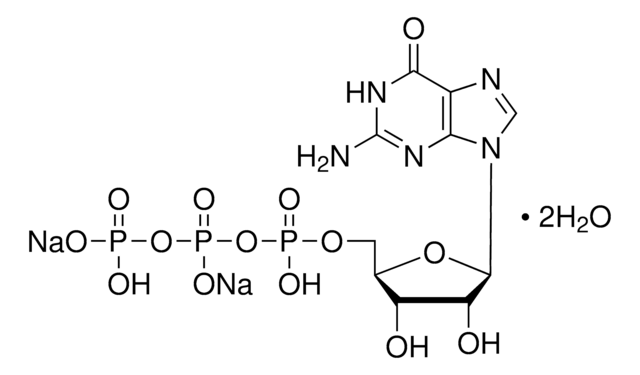51060
Guanosine 5′-diphosphate disodium salt
≥90% (HPLC)
Synonym(s):
5′-GDP-Na2
About This Item
Recommended Products
biological source
Porcine brain
microbial (Corynebacterium sp)
synthetic
Assay
≥90% (HPLC)
form
powder
solubility
H2O: 50 mg/mL, clear, colorless
shipped in
dry ice
storage temp.
−20°C
SMILES string
[Na+].[Na+].NC1=Nc2c(ncn2[C@@H]3O[C@H](COP([O-])(=O)OP(O)([O-])=O)[C@@H](O)[C@H]3O)C(=O)N1
InChI
1S/C10H15N5O11P2.2Na/c11-10-13-7-4(8(18)14-10)12-2-15(7)9-6(17)5(16)3(25-9)1-24-28(22,23)26-27(19,20)21;;/h2-3,5-6,9,16-17H,1H2,(H,22,23)(H2,19,20,21)(H3,11,13,14,18);;/q;2*+1/p-2/t3-,5-,6-,9-;;/m1../s1
InChI key
LTZCGDIGAHOTKN-LGVAUZIVSA-L
Related Categories
General description
Application
- in fluorescent metal nanoclusters selectivity of guanosine 3′-diphosphate-5′-di(tri)phosphate, ppGpp
- in screening of fluorescence emission of hypocrellin A-zinc complex
- as a component of assay buffers in the autoradiography of mice brain sections
Biochem/physiol Actions
Storage Class Code
11 - Combustible Solids
WGK
WGK 3
Flash Point(F)
Not applicable
Flash Point(C)
Not applicable
Personal Protective Equipment
Certificates of Analysis (COA)
Search for Certificates of Analysis (COA) by entering the products Lot/Batch Number. Lot and Batch Numbers can be found on a product’s label following the words ‘Lot’ or ‘Batch’.
Already Own This Product?
Find documentation for the products that you have recently purchased in the Document Library.
Customers Also Viewed
Our team of scientists has experience in all areas of research including Life Science, Material Science, Chemical Synthesis, Chromatography, Analytical and many others.
Contact Technical Service










![Guanosine 5′-[γ-thio]triphosphate tetralithium salt ≥90% (contains < 10% GDP, HPLC), powder](/deepweb/assets/sigmaaldrich/product/structures/131/514/e3025b6a-cb52-4818-b20f-98efac485c1a/640/e3025b6a-cb52-4818-b20f-98efac485c1a.png)

